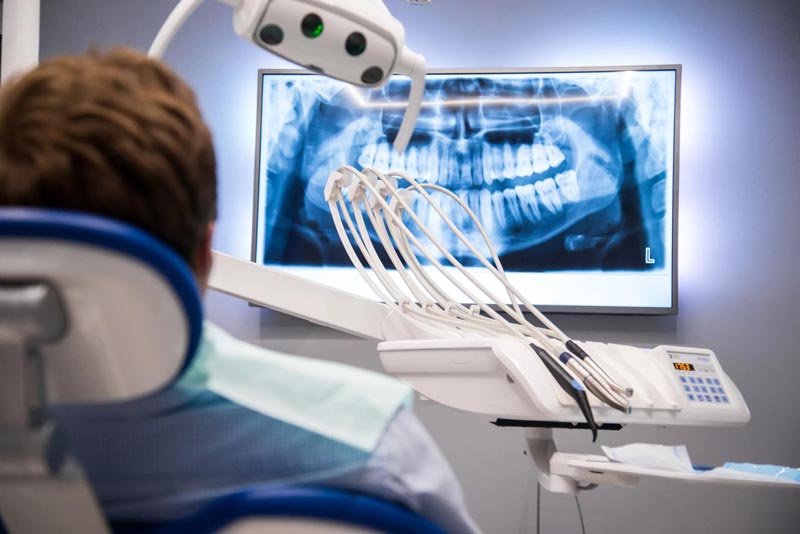X-Rays Help Dentists Detect Hidden Issues

Taking care of your oral health should be a priority for everyone. Even if you have never had any issues with your teeth, you should take the appropriate steps to ensure your teeth remain in good shape. You can do this by engaging in proper oral hygiene habits, such as brushing your teeth twice a day and flossing daily. Additionally, you should also be receiving a dental cleaning at least twice a year. However, dental x-rays are just as important in maintaining your oral health.
While regular examinations are great at detecting many issues within your mouth and teeth, not all diseases or conditions can be detected during a typical exam. Dental x-rays help your dentist uncover any oral diseases that are not visible to the naked eye.
Many health concerns don’t make themselves known until the condition has progressed. However, dental x-rays help prevent these conditions from becoming truly serious matters. From cavities to gum disease, x-rays are extremely important to your overall oral health.
Cosmetic & Family Dentistry of Las Colinas utilizes dental x-rays to ensure that the state of our patients’ teeth is well maintained.
Problems Detected by X-Rays
As we mentioned, there are plenty of issues that regular exams cannot detect. Only with the help of dental x-rays will your dentist be able to uncover certain issues. Some of these issues may be:
- Uncover areas of decay
- Identify decay under restorative work
- Detect bone loss
- Help oral care experts in preparation for extractions, implants, braces, and other dental procedures
- Reveal the existence of any cysts, abscesses, tumors, or other masses, according to the Academy of General Dentistry
- Monitor the development of wisdom teeth
- Monitor the development of adult teeth in children
Types of X-Rays
Dentists use x-rays to help them determine if your teeth are in good health. In order to do that, your dentist will employ the use of several different types of x-rays. Each x-ray has a different purpose and allows your dentist to focus on one area of your mouth. These types are:
- Bitewing: To take the image needed for a bitewing x-ray, you must bite down on a special piece of paper. When biting down, your dentist will examine how well the crowns of your teeth match up. They are used to check for cavities between teeth and any changes in bone density.
- Occlusal: Your jaw must be closed for an occlusal x-ray to see how well your upper and bottom teeth line up. They show full tooth development and reveal the entire arch of teeth on either the bottom or upper jaw.
- Periapical: A periapical x-ray shows the entire tooth, from the crown to the end of the root connected to the jaw. Dentists use these to detect any abnormalities.
Extraoral X-Rays:
All the types of x-rays discussed so far have been intraoral x-rays, meaning they are taken inside the mouth. Extraoral x-rays are those taken outside of the mouth. These x-rays do show your teeth, but their main focus is your jaw and skull. They don’t provide the detail that intraoral do, which means they aren’t good at detecting cavities. What they are good at is looking for impacted teeth, monitor tooth growth, and focus on the development of your jaw.
For example, a panoramic x-ray shows your entire mouth. A machine rotates around your entire head to create a full picture of your mouth. Dentists use this to check your wisdom teeth, identify tumors, diagnose impacted teeth, and much more.
How Often Should You Get Dental X-Rays?
The health of everyone’s mouth is different. No two people have the same teeth nor the same problems. While it’s a good rule of thumb to have dental x-rays conducted every year, some people need them more often than others. New patients will almost always have a set of x-rays done on their first visit.
There are those who require x-rays far more frequently, however, including:
- Children: Children need more x-rays than adults because their teeth are still developing. They are constantly losing their baby teeth while growing adult teeth. Dentists use these images to monitor their development, determining if any baby teeth need extraction and adult teeth are growing properly.
- Adults with Restorative Work: X-rays help track any decay under fillings, crowns, or other restorative work.
- Those with Gum Disease: Gum disease is a real threat to the health of your teeth. It can even lead to bone loss, which x-rays can easily detect.
- Smokers: Smoking is extremely dangerous to the entire body, even your mouth. Smokers have an increased risk of periodontal disease and oral cancer.
Safety
It is completely understandable that some individuals might be worried about the potential dangers of receiving dental x-rays, especially since they are conducted on your head. While those worries are understandable, you are perfectly safe.
Through technological advancements, dental x-rays are much safer than they have ever been. Digital imaging is a brand-new technique that many doctors utilize. This new technique uses far less radiation than traditional x-rays, while also reducing the wait time for image development.
While relatively safe, the American Dental Association (ADA) Mouth Healthy still recommends that patients be protected with a leaded apron that covers the abdomen and a leaded collar to protect their thyroid.
Oral care experts have worked diligently to ensure that all patients are protected when receiving x-rays. However, if you are pregnant or suspect you may be pregnant, x-rays may not be safe.
Dental x-rays have proven to be an extremely helpful tool for all dentists across the world. They provide them with an opportunity to detect any hidden issues you may have. There is no reason to worry, as well. Dentists employ techniques that reduce the level of radiation to ensure all patients are protected. If you are in need of dental x-rays or require other dental procedures, contact Cosmetic & Family Dentistry of Las Colinas today.
- Awareness16
- Bad Breath1
- Bone Grafting1
- Braces4
- Causes, Symptoms, And Treatments6
- Cavities5
- Chewing Gum1
- Cosmetic Dentistry of Las Colinas15
- COVID-192
- Deep Cleaning7
- Dental Anxiety1
- Dental Bridge2
- Dental Care27
- Dental Cleaning6
- Dental Crown1
- Dental Filling1
- Dental Health24
- Dental Implants6
- Dental Sedation1
- Dental Visit1
- Dental X Ray3
- Floss1
- Gum Dieseases4
- Injury1
- Insurance1
- Invisalign8
- Oral Cancer1
- Oral Hygiene24
- Root Canal9
- Sleep Apnea2
- Tartar1
- Teeth19
- Thanksgiving1
- TMJ1
- Tongue1
- Veneers2
- White Teeth12
Get Your Best Smile With Us
